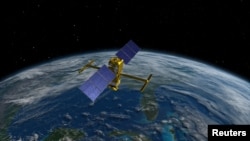The United States privately warned Russia not to deploy nuclear weapons in space, The Wall Street Journal reported on February 22. The warning followed media reports citing U.S. intelligence sources as saying that Moscow’s plans to develop a nuclear space weapon pose a serious threat to U.S. national security.
The warning to Russia is “part of a diplomatic campaign that the Biden administration is mounting to head off the threat that also involves approaches to China, India, G-7 nations and other close allies that have interests in space and channels to Moscow,” the WSJ wrote.
While the details of the U.S. intelligence findings remain classified, the White House said Russia is seeking to put a nuclear weapon into space for possible use against satellites.
Russian President Vladimir Putin dismissed the allegations as “unfounded, fake, and false.”
Addressing Russia’s parliament on February 29, Putin said Moscow has no plans to deploy nuclear weapons in outer space and accused the U.S. of blocking a Russia-drafted agreement that would ban such deployments:
"They [the U.S.] have recently made unfounded allegations, in particular, against Russia, regarding plans to deploy nuclear weapons in space. Such fake narratives, and this story is unequivocally false, are designed to involve us in negotiations on their conditions, which will only benefit the United States,” Putin said.
“At the same time, they have blocked our proposal which has been on the table for over 15 years. I am referring to the agreement on preventing the deployment of weapons in outer space, which we drafted back in 2008. There has been zero reaction to it.”
That is misleading.
Putin failed to mention that the 1967 Outer Space Treaty bans the deployment of nuclear weapons in outer space. Both the United States and the then Soviet Union were among the 110 nations that ratified the treaty. Another 89 countries signed the treaty but have not yet ratified it.
This treaty prohibits the placement of “nuclear weapons or any other kinds of weapons of mass destruction” in Earth's orbit, on the Moon or any other celestial body, or on a station in outer space. In addition to nuclear weapons, the term “weapons of mass destruction” includes chemical, biological and radiological weapons.
In citing the “agreement on preventing the deployment of weapons in outer space” drafted in 2008, Putin was referring to the “Treaty on Prevention of the Placement of Weapons in Outer Space and of the Threat or Use of Force Against Outer Space Objects,” or PPWT, which Russia and China presented jointly at the U.N-backed Conference on Disarmament in Geneva in 2008.
The U.S. opposed the Sino-Russian draft treaty mainly because it did not take into account the ground-based anti-satellite systems that China and Russia are actively developing.
In June 2014, Russia and China presented an updated PPWT draft, which again did not include the systems capable of hitting satellites from the ground. As of 2024, the U.S., China, India and Russia have developed and successfully tested such systems, reportedly destroying satellites.
Four U.S. presidents have been in office since the PPT was drafted in 2008, and all of them expressed the following concerns (as voiced on March 22, 2022, at the Conference on Disarmament in Geneva, by Michael Aho, then advisor to the U.S. delegation to the conference}:
- The draft does not take into account “anti-satellite weapons by countries that seek to deny other countries’ use and benefits of outer space through ground-based systems, which represent the most pressing threats to on orbit systems today”;
- PPWT does not offer any verification mechanisms, thus “verification of compliance by others cannot be achieved”;
- The draft’s broad use of language allows manipulation. For instance, “weapons in space” cannot be defined because many space systems have dual purposes.
- The draft “fails to address concerns about a potential stockpiling and breakout capabilities as well as potentially troubling behavior by Russian space objects operating in the vicinity of U.S. space objects.”
According to Kari Bingen, director of the Aerospace Security Project at the Center for Strategic and International Studies in Washington D.C., a conventional anti-satellite missile can destroy only one satellite, while a nuclear anti-satellite missile can destroy many satellites and cause strategic damage:
“A nuclear detonation in space, I see as a one versus many weapon. If your aim is to target and take out as many satellites as you can, you might seek this nuclear option. To create a large detonation, that fries any satellites within range, and then creates a high-radiation environment that degrades even more satellites over time.”





